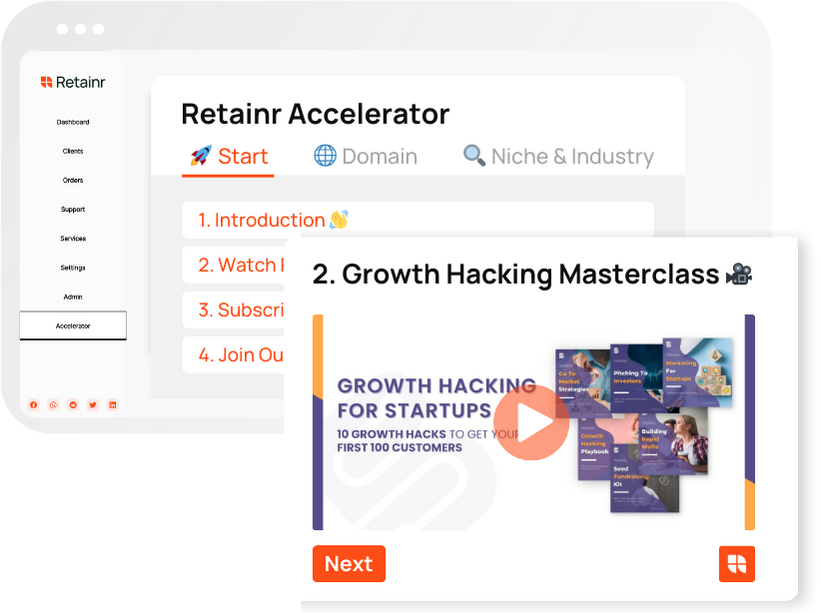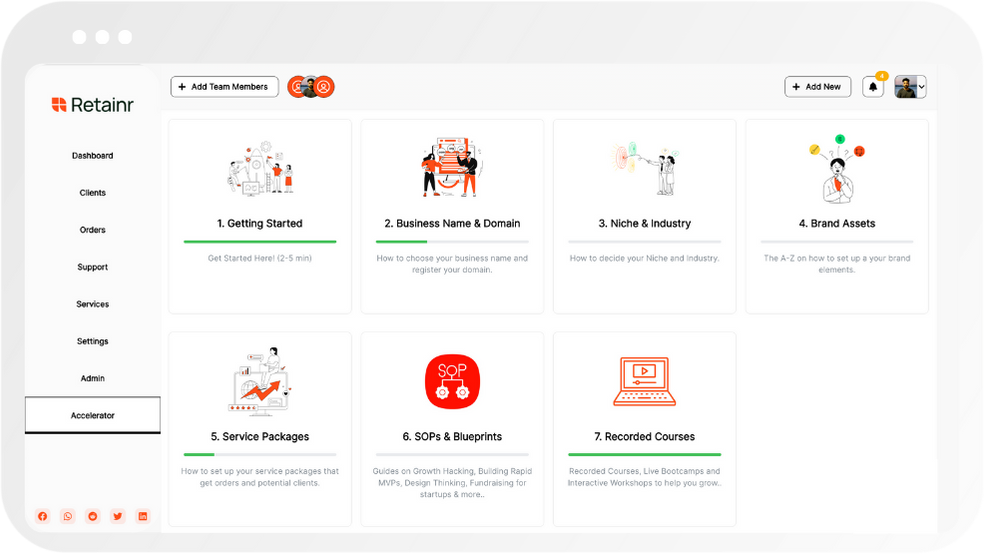
7 Technologies to Streamline Business Processes
Build with Retainr
Sell your products and services, manage clients, orders, payments, automate your client onboarding and management with your own branded web application.
Get Started1. What are the seven technologies used to streamline business processes?
Technology Tools for Business Streamlining
Advances in technology have enhanced the means of managing business processes, improving efficiency, and efficacy. Here are seven technologies that businesses can leverage to streamline operations:
- Cloud Computing
- Artificial intelligence (AI) and Machine Learning (ML)
- Data Analytics
- Internet of Things (IoT)
- Robotic Process Automation (RPA)
- Enterprise Resource Planning (ERP) Systems
- Customer Relationship Management (CRM) Systems
Details on How Technologies Streamline Business Processes
These technologies, when integrated into a company's operations, can offer substantial benefits by improving workflow and efficiency. Below is an overview of how each technology can streamline business processes:
| Technology | Description |
|---|---|
| Cloud Computing | Allows businesses to store and access data in remote servers, improving data security, accessibility, and scalability. |
| Artificial Intelligence and Machine Learning | These technologies automate tasks, analyze data, and make predictions, leading to reduced human error and faster decision-making. |
| Data Analytics | Aids in the evaluation of business data and trends to inform strategic decision-making and improve operational efficiency. |
| Internet of Things (IoT) | Connects devices and systems, facilitating real-time data collection and integration, boosting productivity, and operational efficiency. |
| Robotic Process Automation (RPA) | Automates repetitive tasks, freeing up staff time for higher-level tasks, and increasing productivity. |
| Enterprise Resource Planning (ERP) Systems | An integrated system that manages and integrates a company’s finance, supply chain, operations, reporting, manufacturing, and human resource activities. |
| Customer Relationship Management (CRM) Systems | Helps manage and analyze customer interactions and data throughout the customer lifecycle to improve business relationships and drive sales growth. |
2. How can these technologies improve my business's efficiency?
Improving Business Efficiency with Technologies
These technologies significantly enhance business efficiency in a variety of ways. The first way is through automation. Instead of manually carrying out repetitive tasks, businesses can leverage software like Robotic Process Automation (RPA) and Artificial Intelligence (AI) to automate them. This can save a considerable amount of time and allow employees to focus on more critical tasks. Technologies like Cloud Computing and Software-as-a-Service (SaaS) provide companies with scalable resources, ensuring they only use and pay for what they need, reducing wastage.
The second way technologies can improve your business's efficiency is through better decision making. With technology such as Business Intelligence (BI) and Big Data, firms have access to real-time data and analytics, which can guide strategic decisions, reduce risks, and foresee trends. Also, workflow management software can help in streamlining business operations, eliminating bottlenecks, and improving the overall productivity.
| Technology | Benefit |
|---|---|
| RPA and AI | Automating repetitive tasks |
| Cloud Computing and SaaS | Scalable resources and reduced wastage |
| BI and Big Data | Access to real-time data and analytics |
| Workflow Management Software | Streamlining operations and improving productivity |
3. How does automation technology help in streamlining business processes?
Understanding Automation Technology in Business
Automation technology refers to the use of systems, machines, or software applications to carry out tasks that would normally require human intervention; thus, increasing productivity and accuracy. It plays a critical role in streamlining business operations, contributing to improved efficiency and effectiveness.
- Reduce human error: Automation technology can perform repetitive tasks more accurately than humans, reducing the risk of mistakes.
- Improve efficiency: With automation, tasks are performed quickly and seamlessly, improving the overall efficiency.
- Save time and resources: When tasks are automated, it frees up time and resources that can be used more strategically.
Role of Automation Technology in Various Business Aspects
Automation technology has a far-reaching impact on a wide range of business aspects including sales, customer service, HR, and more. Its application in these fields helps in enhancing not just productivity but also quality of services.
| Business Aspect | Role of Automation Technology |
|---|---|
| Sales | Automation in sales can help track leads and update customer information thereby streamlining the sales cycle. |
| Customer service | Chatbots and other automated customer service solutions can provide quick responses to customer queries, elevating customer experience. |
| HR | With automation, HR processes such as payroll, recruitment, and others can be simplified and made more efficient. |
Future of Automation Technology in Business
As businesses strive towards operational efficiency, automation technology will continue to evolve. We can anticipate more advanced and versatile automation tools that offer enhanced capabilities and performance. From AI-powered software to robotics and machine learning algorithms, the face of business automation is set to be transformed.
- The Internet of Things (IoT): This technology will connect and automate business processes even more seamlessly.
- AI and Machine Learning: They will make automation smarter, capable of performing complex tasks that currently require human intelligence.
- Robotic Process Automation (RPA): RPA will automate repeatable tasks and free up resources for more strategic work.
4. How can AI and machine learning streamline business operations?
Optimization of Business Operations with AI and Machine Learning
Artificial Intelligence and Machine Learning are increasingly significant technologies for streamlining business operations. These technologies implement advanced algorithms to analyze data quickly, optimize business processes, and consequently facilitate more effective decision-making. Several ways in which AI and Machine Learning streamline business operations include:
- Automating Administrative Tasks: Through intelligent automation, routine administrative tasks such as data entry, inventory management, and scheduling are automated, leading to significant time-saving and higher productivity.
- Improving Customer Service: AI-driven chatbots can respond to customer inquiries 24/7, guiding customers through the resolution of minor issues or escalating more complex problems to human personnel.
- Enhancing Decision-Making: Machine learning algorithms can aid decision-making by identifying patterns and trends in data that may not be noticeable to human analysis. This allows businesses to make strategic decisions based on predictive analytics.
AI and Machine Learning Application Examples
Various industries have implemented AI and Machine Learning technologies to streamline their operations. Here are a few examples:
| Industry | Application |
|---|---|
| Retail | AI technology is used in inventory optimization, personalized shopping experience, and automated checkouts. |
| Healthcare | Machine learning algorithms help in diagnosing illnesses, improving drug formulation, and optimizing patient treatment plans. |
| Finance | AI can streamline operations by improving fraud detection, automating data analysis, and enhancing customer relationship management. |
The Future of AI and Machine Learning in Business
As technologies evolve, the roles of AI and Machine Learning in business are set to expand. Businesses must embrace these technologies to stay competitive, enhance productivity, and propulse innovation. Potential future applications could include:
- Advanced Personalization: Advanced algorithms will enable even deeper personalization, predicting customer needs and preferences with greater accuracy.
- Next-Generation Automation: AI-driven automation could extend to more complex tasks, such as strategic planning and project management.
- Smart Infrastructure: The integration of AI and IoT could lead to smart infrastructure, optimizing resource use and maintenance in real-time.
5. Are there particular industries or types of businesses that benefit more from these technologies?
Industries Benefitting from Streamlining Technologies
There are many industries and types of businesses that can greatly benefit from the use of streamlining technologies. From healthcare and retail, to manufacturing and logistics — the implementation of such technologies has the potential to immensely boost productivity, reduce costs, and improve service quality. Here are a few of these industries:
- Healthcare: With an increased demand for efficient patient care, technologies like Electronic Health Records (EHRs), Telemedicine, and AI-enabled medical devices can streamline numerous operational processes.
- Retail: Technologies such as AI-based customer service, automated inventory management, and e-commerce solutions can simplify many complex retail processes.
- Manufacturing: Digital manufacturing technology, automation tools, and predictive maintenance systems can significantly speed up the manufacturing process while minimizing errors.
- Logistics: From improved delivery route planning through GPS technologies to AI-powered inventory management, logistics are becoming smoother and cost-effective.
Top Streamlining Technologies by Industry
To illustrate the impact of streamlining technologies more precisely, let's examine the following table. It shows the top technologies revolutionizing each mentioned industry:
| Industry | Top Streamlining Technologies |
|---|---|
| Healthcare | Electronic Health Records (EHRs), Telemedicine, AI-enabled medical devices |
| Retail | AI-based customer service, Automated inventory management, E-commerce solutions |
| Manufacturing | Digital manufacturing technology, Automation tools, Predictive maintenance systems |
| Logistics | GPS route planning technology, AI-powered inventory management |
Adoption of Streamlining Technologies - An Ongoing Process
While some industries are early adopters and are already reaping the benefits of streamlining technologies, others are still in the consultation or early implementation stages. Regardless of the industry, these digital solutions represent a powerful tool that can dramatically enhance operational efficiency. Overall, the level of benefit any given industry or business can gain from these technologies tends to correlate with the level of their digital maturity and their willingness to embrace innovation.
6. What is the role of cloud computing in streamlining business processes?
The Role of Cloud Computing in Streamlining Business Processes
Cloud computing plays a significant role in streamlining business processes by providing a platform for storing, managing, and processing data. It offers several benefits that can greatly enhance business operations. The main advantages incorporate cost efficiency, increased productivity, and collaboration effectiveness.
- Cost Efficiency: Cloud computing eliminates the need for purchasing expensive hardware and software. Businesses can save on costs related to maintenance, power consumption, upgrading, and support. They pay only for the resources used, thus making it a cost-effective solution.
- Increased Productivity: With cloud computing, there is no limitation on data access. Employees can access data anytime, from anywhere, hence contributing to increased productivity. It also spares the business from the hassle of managing IT infrastructure, allowing them to focus on their core tasks.
- Collaboration Effectiveness: Cloud computing promotes collaboration among team members by providing a shared platform where they can work together in real-time. This leads to quicker decision making and an increase in efficiency.
| Features | Benefits |
|---|---|
| Cost Efficiency | Reduction in hardware and software cost, maintenance, power consumption, upgrade, and support |
| Increased Productivity | Unlimited data access, focus on core tasks |
| Collaboration Effectiveness | Promotion of real-time teamwork, quicker decision making, increased efficiency |
Ultimately, cloud computing paves the way for businesses to be more flexible and responsive to market dynamics. It not only assists businesses in reducing operating costs but also gives them an edge over their competitors. By adopting cloud computing, businesses can achieve streamlined operations which would be beneficial for their growth and success.
7. How do these technologies impact communication in businesses?
Impacts of Technologies on Business Communication
With the integration of advanced technologies like AI, Cloud storage, IoT, Data Analytics, CRM software, Automation tools, and ERP software, business communication has considerably improved in various ways. They have brought about a revolution in business processes by enhancing reliability, efficiency, and real-time communication.
- AI: Artificial Intelligence have automated communication in businesses. Chatbots are one example which can engage with customers, thus freeing the staff to focus on other vital tasks.
- Cloud Storage: The Cloud provides a platform for easy file sharing and collaboration, thus encouraging seamless team communication.
- IoT: IoT devices have enhanced real-time tracking and reporting, leading to effective decision-making process.
- Data Analytics: It helps in generating insightful reports, assisting businesses in communicating the right information to stakeholders.
- CRM Software: Customer Relationship Management software simplifies communication with clients and enhances customer responsiveness.
- Automation Tools: Automation tools streamline repetitive tasks thus reducing errors and improving internal communication.
- ERP Software: Enterprise Resource Planning improves inter-departmental communication and workflow.
These technologies have altered the landscape of business communication, making them more dynamic and productive.
Table showing technologies impact on communication in businesses
| Technology | Impact |
|---|---|
| AI | Automates communication and customer engagement |
| Cloud Storage | Enhances file sharing and collaboration |
| IoT | Improves real-time tracking and decision making |
| Data Analytics | Assists in communicating insightful information |
| CRM Software | Enhances communication with clients |
| Automation Tools | Minimizes errors and improves internal communication |
| ERP Software | Improves inter-departmental communication and workflow |
8. Can you explain how data analytics helps in optimizing business processes?
Understanding the Role of Data Analytics in Business Processes
Data analytics aids businesses in optimizing their operations in various ways. Primarily, it allows for the systematic analysis of raw data with the aim of drawing meaningful conclusions which can inform decision making. With the proliferation of digital tools, businesses are able to generate a large volume of data, but the key to optimization is understanding how to use this data effectively.
Benefits of Data Analytics in Business Processes
- Increased Efficiency: Data analytics can highlight areas of inefficiencies in an organization’s processes, paving the way for necessary improvements.
- Improved Decision Making: Analytics gives businesses the data they need to make informed decisions. This evidence-based tactic can lead to more favorable outcomes compared to decision-making based on instinct or anecdotal evidence.
- Predictive Capabilities: Predictive analytics can be used to identify trends and patterns, facilitating forecasting future outcomes and trends. Consequently, businesses can be better prepared and make strategic decisions based on their forecasted data.
- Enhanced Customer Service: Analyzing customer data allows businesses to understand their clients' behavior and preferences better, leading to personalized interactions and increased customer satisfaction.
Data Analytics Tools for Business Processes
| Tool | Description |
|---|---|
| Google Analytics | This tool allows businesses to track and analyze their website traffic, offering insights into user behavior and preferences. |
| Tableau | Tableau is a data visualization tool that can transform raw data into an understandable format, enabling businesses to comprehend their data better and make informed decisions. |
| Power BI | Microsoft’s Power BI is a suite of business analytics tools which allows users to analyze data and share insights across their organization. |
9. How does management software help in the streamlining of business operations?
Efficiency and Productivity of Management Software
Management software, a type of business technology, streamlines operations by automating routine tasks, upgrading data management, and enhancing communication among employees. The automation of routine tasks, such as document filing or calendar updates, allows employees to focus more on strategic initiatives thereby enhancing productivity. Data management is upgraded as software can immediately compile, analyze, and visualize data for decision making. Enhancing communication, management software can serve as a central hub for collaboration and knowledge sharing.
| Management Software Features | Benefits |
|---|---|
| Task Automation | Increases focus on strategic initiatives |
| Data Management | Immediate data analysis and visualization |
| Communication Enhancement | Facilitates better collaboration and knowledge sharing |
Integration and Customization
Management software can be integrated with other systems, meaning this tool can pull in data from different places in the organization, providing a unified view of operations. This is useful in tracking performance or identifying bottlenecks. In addition, management software is flexible enough to be customized according to unique business needs. Some companies may need more employee engagement features, while others require stronger security measures.
- Integration: Unifies data, useful for performance tracking and identifying bottlenecks
- Customization: Offers flexibility to cater to unique business needs
Investment and Return
While there may be an initial investment required for the incorporation of management software, the benefits, such as improving efficiency, reducing errors, and providing valuable insights for decision making, often result in a substantial return on investment. The software can essentially pay for itself over time. The improved efficiency and productivity, integration and customization capabilities, and the potential return on investment are all reasons why management software can be a significant asset in streamlining business processes.
10. What are the challenges or risks involved in implementing these technologies?
Implementation Challenges of New Technologies
Even though most businesses are fully aware of the benefits offered by new technologies for streamlining processes, the implementation process is often fraught with challenges. Some common difficulties include:
- High Initial Cost: This often tops the list. New technologies often come with a hefty price tag, which some businesses may find difficult to afford.
- Lack of Technological Expertise: Assuming that every member of your team will effortlessly adapt to new technologies is unrealistic. Some employees may struggle, which could disrupt your usual business processes.
- Data Security: With process automation, large amounts of confidential business data becomes digitized. This data is potentially at risk from hackers, which could have devastating effects on business operations and reputations.
Risk Factors in Implementing Technologies
Aside from challenges in implementation, there are also several risk factors businesses must consider when adopting new technologies to streamline their operations. These include but are not limited to:
| Risk Factor | Description |
|---|---|
| Reliance on Technology | Once a business begins to rely on new technology, any malfunction or downtime can severely impact productivity. |
| Data Loss | Digital storage systems are vulnerable to incidents leading to data loss, such as cyber attacks or system crashes. Loss of critical data can be catastrophic for a business. |
| Resistance to Change | Employees may resist adopting new technologies, which can slow down or disrupt the implementation process. |
Overcoming Challenges and Risks
Planning for these challenges and risks upfront can lead to smoother transitions and greater success in implementing new technologies. Some precautionary measures can include:
- Investing in proper training for employees
- Implementing data security protocols
- Testing systems thoroughly before implementation
- Having a contingency plan in case of technology failure
While adopting new technologies involves some risk, the potential for increasing efficiency and streamlining business processes often outweighs these concerns.
Conclusion
Staying Ahead with Technology to Streamline Operations
In the modern world, staying ahead of competition and keeping pace with advancements are integral aspects to thriving in business. Technologies to streamline business operations not only reduce manual tasks, but also improve accuracy, efficiency, and ultimately, your bottom line. Let’s explore seven such technologies that can act as game-changers for your enterprise.
Technology Solutions for Superior Business Management
Emerging technologies such as Cloud Computing, Artificial Intelligence, Robotic Process Automation, Blockchain, Internet of Things (IoT), Augmented Reality (AR) and Virtual Reality (VR) are revolutionizing the way businesses operate. These innovations offer various benefits like real-time data access, improved decision-making, enhanced security, and automated routine tasks.
Unlock the Power of Whitelabel Software: Retainr
Apart from these, another innovative technology solution that firms can explore is Retainr.io – your very own whitelabel software. Retainr allows you to manage clients, sell products or services, track orders, and handle payments all under one roof. With your own branded app, you can not only ensure a streamlined business process, but also foster trust among your clients, giving them a personalized platform to engage with your brand.
Key Benefits of Using Retainr.io
Retainr.io enables businesses to seamlessly manage various aspects of their operations. Key benefits include smooth order processing, simplified client management, efficient payment handling, and more. the Retainr platform does all this while enhancing your brand identity by incorporating your business's unique attributes into the app design.
Conclusion
Adopting a tech-based approach to business management is no longer optional but a necessity in the modern landscape. Technologies like Retainr.io offer a convenient and effective way to manage your business operations while boosting brand visibility. Explore the capabilities of Retainr.io today for a streamlined, efficient, and more manageable business process.
Boost Your Agency Growth
with Retainr Accelerator
Uncover secrets, strategies, and exclusive blueprints to take your agency's growth to the next level — from marketing insights to effective presentations and leveraging technology.

SOPs, Cheatsheets & Blueprints
Leverage 50+ SOPs (valued over $10K) offering practical guides, scripts, tools, hacks, templates, and cheat sheets to fast-track your startup's growth.
Connect with fellow entrepreneurs, share experiences, and get expert insights within our exclusive Facebook community.
.jpg)

Join a thriving community of growth hackers. Network, collaborate, and learn from like-minded entrepreneurs on a lifelong journey to success.

Gain expertise with recorded Courses, Live Bootcamps and interactive Workshops on topics like growth hacking, copywriting, no-code funnel building, performance marketing and more, taught by seasoned coaches & industry experts.

.jpg)

.jpeg)


